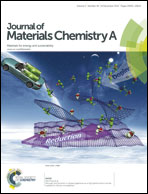Pseudocapacitive slurry electrodes using redox-active quinone for high-performance flow capacitors: an atomic-level understanding of pore texture and capacitance enhancement†
Abstract
Electrochemical flow capacitors (EFCs) are highly promising for grid-scale energy storage since they benefit from having advantages of both electrochemical capacitors and flow batteries, including their high power density, long cycle lifetime, and scalable energy capacity. Here, we demonstrate a high-performance flow capacitor using redox-active hydroquinone (HQ)-based pseudocapacitive slurry electrodes. The maximum capacitance value of 513 F g−1 is attainable for a slurry with a 0.38 M HQ redox mediator. Considering both the rate performance and capacitance of slurry electrodes, the optimum HQ concentration is 0.3 M of HQ. The as-prepared slurry electrodes show the highest capacitance and energy density (∼14 W h kg−1) among the previously reported slurry electrodes for aqueous flow capacitors. Furthermore, we performed first-principles calculations to understand the effect of HQ grafting on the activated carbon pore texture and the origin of increased capacitance by HQ mediators at the electrolyte and electrode interface.


 Please wait while we load your content...
Please wait while we load your content...